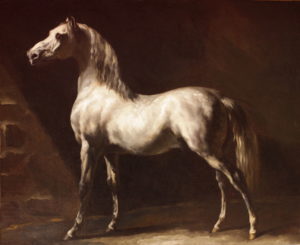Why is a French museum sparking controversy with its ongoing exhibition of horse paintings by the Romantic master Théodore Géricault?
The Musée de la Vie Romantique is one of Paris’s many small museums. Located at the base of the hill of Montmartre in the 9th arrondissement, it is dedicated to the Romantic era, with its permanent collection featuring all sorts of artworks, documents, jewelry, and other memorabilia related to the era’s painters, sculptors, composers, and literary figures. Since opening as a museum in 1982, it has hosted exhibitions dedicated to all aspects of the Romantic period, focusing on figures like Frédéric Chopin and William Blake. Its current exhibit, which opened last month, is dedicated to the French painter Théodore Géricault to commemorate the two hundredth anniversary of his death. Though best known for his 1819 painting The Raft of Medusa, Géricault covered many subjects in his short but impactful career. One of his most prolific subjects was horses. As a student during the Napoleonic era, he often traveled to Versailles, where he spent time in the palace stables to make studies and drawings of the horses there. During his career, he painted horses on their own, at the races, and in their military capacity. The Musée de la Vie Romantique has centered its entire exhibition on Géricault’s horse paintings. However, the museum is receiving much criticism from the scholarly and curatorial community because not all the paintings are verified Géricault paintings.
Some of the ninety-seven paintings in Géricault’s Horses have widely accepted positive attributions. These include paintings on loan from the Louvre, the Rouen Musée des Beaux-Arts, and the Lille Palais des Beaux-Arts. However, the museum has included loans from private collections, making up about a third of the exhibition. None of these paintings are included in any of the three catalogue raisonnés. Furthermore, The Art Newspaper reports that only half the works in the entire catalogue have the provenance and other documents required to positively and definitively attribute them to Géricault. Philippe Grunchec, one of the foremost Géricault experts, claims that the rest “are all copies, generally of low quality, inspired by the artist’s paintings or engravings”. The art dealer Jane Roberts stated they were just “a bunch of unknown daubs”, and French art journalist Didier Rykner called them “mediocre”.
While this can be blamed on sloppy scholarship or overlooked details, there is evidence that the museum may have intentionally attributed works to Géricault despite the lack of evidence. About six of the paintings in Géricault’s Horses were all sold at auction while attributed to “follower of”, “circle of”, or “in the manner of” Géricault rather than the artist himself. There are even works indisputably attributed to other artists that have gotten the same treatment. For example, a sketch by Géricault’s contemporary Léon Cogniet on loan from the Musée des Beaux-Arts in Orléans is attributed to Géricault in the exhibition catalogue. The Musée de la Vie Romantique has therefore altered the attribution to either elevate them to full-fledged positive attribution, or to change the attribution entirely.
Some museum directors and curators have strongly criticized Géricault’s Horses for this, calling it “shameful” and “a real disaster”. Daniel Marchesseau, the museum’s former director, penned a letter to the exhibition’s organizers, director Gaëlle Rio and art historian Bruno Chenique, saying that this mismanagement is “destroying the museum’s reputation”. Writing for Le Monde, Roxanne Azimi writes that studying and authenticating a work of art has a good amount of subjectivity, but that doesn’t mean attributions should be thrown around carelessly. “In the absence of bibliographical references or tangible elements of provenance, however, caution prevails.” A true Géricault should languish in scholarly uncertainty because of genuine doubts rather than a student’s or copyist’s work be hastily given the full attribution of the master.
While some museum officials have offered explanations, citing the museum’s small size and limited resources, they seem to overlook a crucial point. The Musée de la Vie Romantique is not just any museum, it is a public institution funded by the city of Paris. It is also part of the Paris Musées, which oversees fourteen museums, including the Victor Hugo House, the Petit Palais, and the Paris Catacombs. These other museums may not be the Louvre, but they have, in the past, demonstrated their commitment to maintaining high standards. They have diligently prepared exhibitions and published scholarly works and catalogues that continue to be used as references among art historians today. It is uncertain whether this scandal will cause any changes in leadership at the museum, though that eventual outcome would not be unsurprising.

